Weekly recap
US indices climbed around 2% across the week, reaching fresh record highs. Stock indices, including the Nasdaq, were boosted by encouraging US-China mood music, robust earnings, and cooler-than-expected US inflation data, which supported the view that the Federal Reserve will be cutting interest rates again this month.
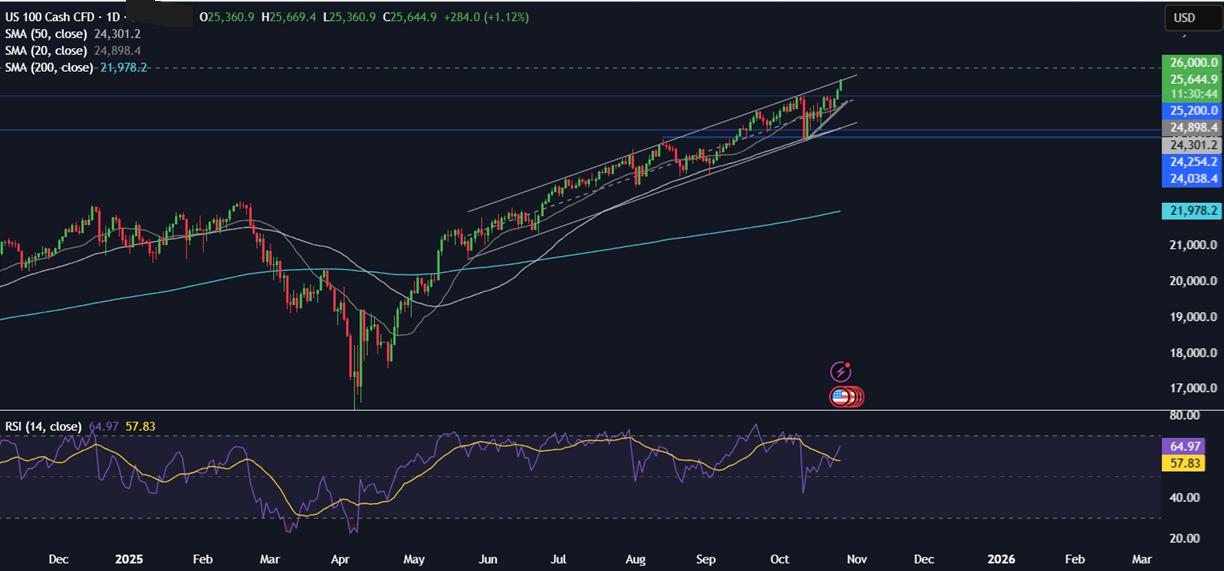
US inflation rose to 3% in September, up from 2.9% in August but below forecasts of 3.1%. Core CPI unexpectedly fell. Meanwhile, the ongoing US government shutdown continued to delay most economic releases.
As the market mood brightened, Gold fell, snapping a nine-week winning streak. The move lower in the precious metal marked the first weekly decline since mid-August, bringing gold prices down from the record high of $4381 to $4120 on Friday.
Crude oil also experienced volatility, with the price snapping a three-week decline after the US imposed sanctions on major Russian oil producers, raising supply concerns. Oil was trading around 6150 per barrel Friday afternoon, up 7% across the week, after briefly sinking to a six-month low at the start of the week.
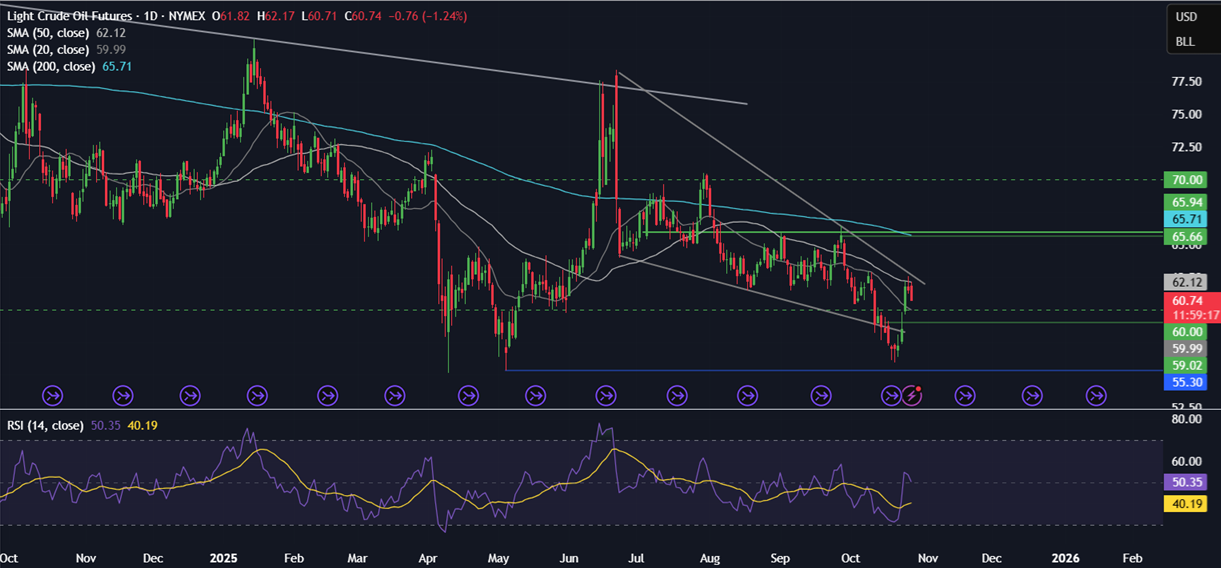
FOMC rate decision (Wednesday)
Despite the absence of key labour market data, the market is still convinced that the Federal Reserve will cut interest rates by 25 basis points on Wednesday to 3.75%-4%. Most policymakers have been clear in their concern over the weakening jobs market. There is still concern about the impact tariffs are having on inflation; however, this appears to be less of a worry than the labour market. The government shutdown is affecting the data release schedule and data collection. However, there are still other avenues to gauge the strength of the US economy. Q3 growth is estimated to be just below 4% and inflation is sticky at 3%. This is likely to keep Federal Reserve officials cautious. With this in mind, the Federal Reserve could opt for a hawkish cut, which may prompt the market to lower rate-cut expectations for December from their currently elevated levels. This could pull stocks off record highs, drag on Gold, and lift the US dollar.
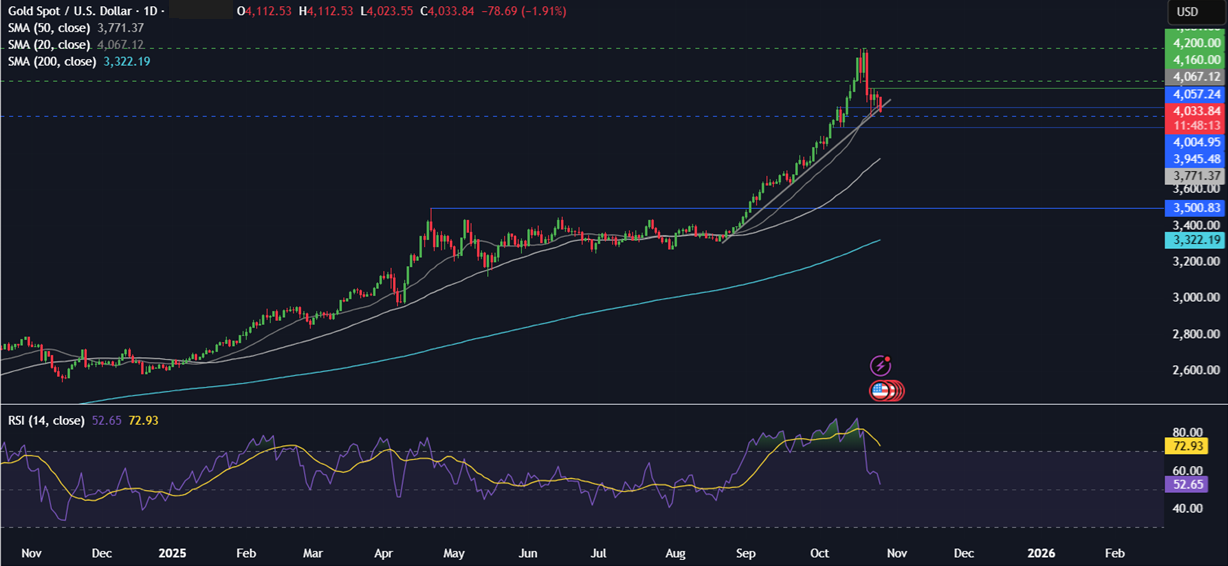
BoC rate decision (Wednesday)
The BoC is expected to reduce rates by 25 basis points to 2.25% but the decision is far from a foregone conclusion. Last month, the BoC cut rates but also abandoned forward guidance, saying that decisions will be made on a shorter horizon than usual as it assesses incoming data. The September CPI rose to 2.4% YoY, up from 1.9% in August, reflecting a pickup in food prices and rising inflationary pressures. However, the business outlook was subdued, with firms expecting cost increases. Trade remains a key focus amid a deterioration in US-Canada trade relations, following the termination of talks, which fueled rate-cut expectations. The market is pricing in a 70% chance of a 25-basis-point rate reduction, down from 77% prior to the CPI data, but still a majority. A dovish-sounding BoC could pull the loonie lower, lifting USD/CAD.
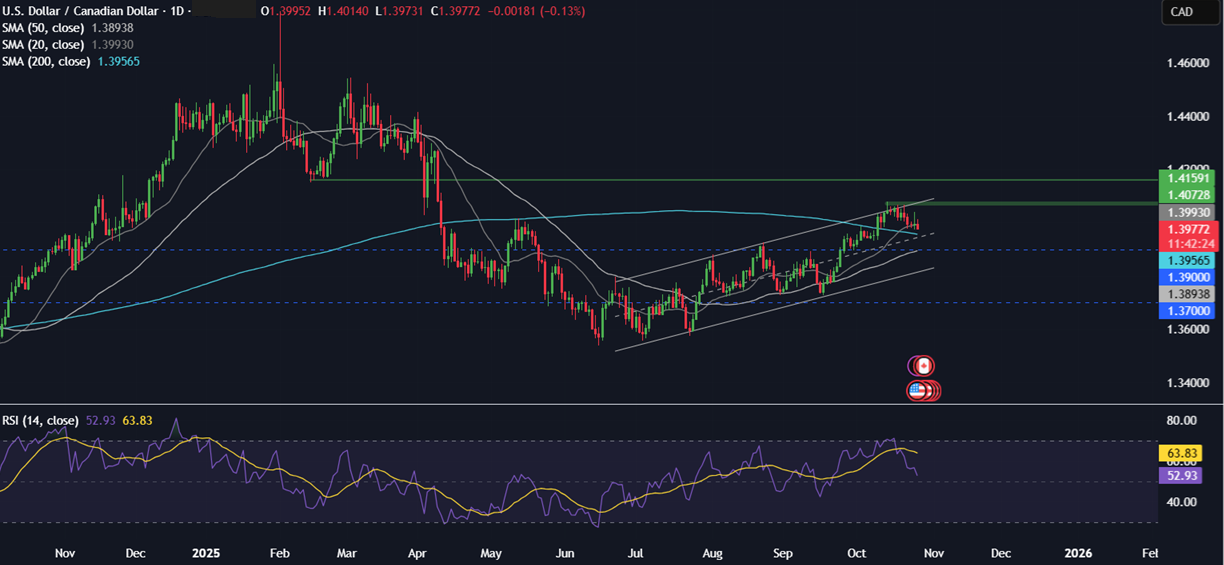
Magnificent seven earnings (Wednesday/Thursday)
This week is the busiest week for Q3 earnings season, which includes earnings from five of the Magnificent 7. These firms are critical drivers of earnings growth and account for a significant share of the S&P 500’s market capitalization, making these earnings key. While Tesla reported last week, Alphabet, Meta, and Microsoft report after the close on Wednesday, and Apple and Amazon report after the close on Thursday. AI investment and returns on this investment will be key themes to watch. Beyond the Magnificent 7, 173 S&P 500 companies are scheduled to report. Of the 29% of the S&P 500 firms that have reported 86% have beaten consensus estimates so far. Stocks are trading at record highs, and expectations are high. Fundamentals need to support the lofty valuations for the rally to continue.
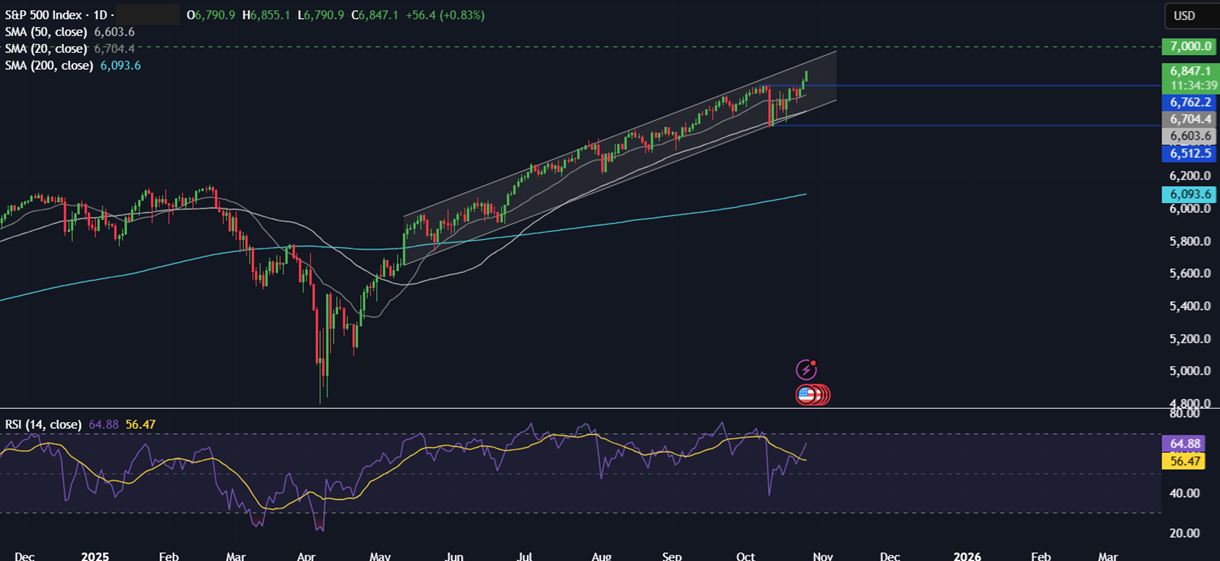
US-China trade talks (Thursday)
President Trump will meet China’s Xi Jinping on October 30 during the APEC Summit in South Korea, marking the first face-to-face meeting between the two leaders since 2019. The talks come after top trade negotiators for the US and China said they reached an agreement on a range of contentious issues, paving the way for the two leaders to finalise a deal and ease trade tensions that have been rattling global markets. US Secretary Bessent said that following high-level talks, Trump’s threat of 100% tariffs is effectively off the table. The improved market mood could keep Gold under pressure in the near term and lift stock indices such as the Dow Jones higher.

ECB rate decision (Thursday)
The ECBC is expected to leave rates unchanged at 2% this week. In the September meeting, the ECB left rates unchanged and reiterated its data-dependent meeting-by-meeting stance, while not committing to any particular rate path. In the meeting, the ECB staff’s projections forecast CPI of just 1.7% in 2026, below the 1.9% consensus, sparking a dovish reaction. However, overall, the EB is in a good place on policy, with inflation only modestly above the 2% target level at 2.2% in September, so there seems little reason to deviate. The recent rise in the euro is also helping keep a lid on the price rebound, as the euro trades 10% higher against the US dollar year to date. Recent PMI data was also stronger than forecast, which is an encouraging sign. The meeting is not expected to have a big impact on the EUR or stocks.
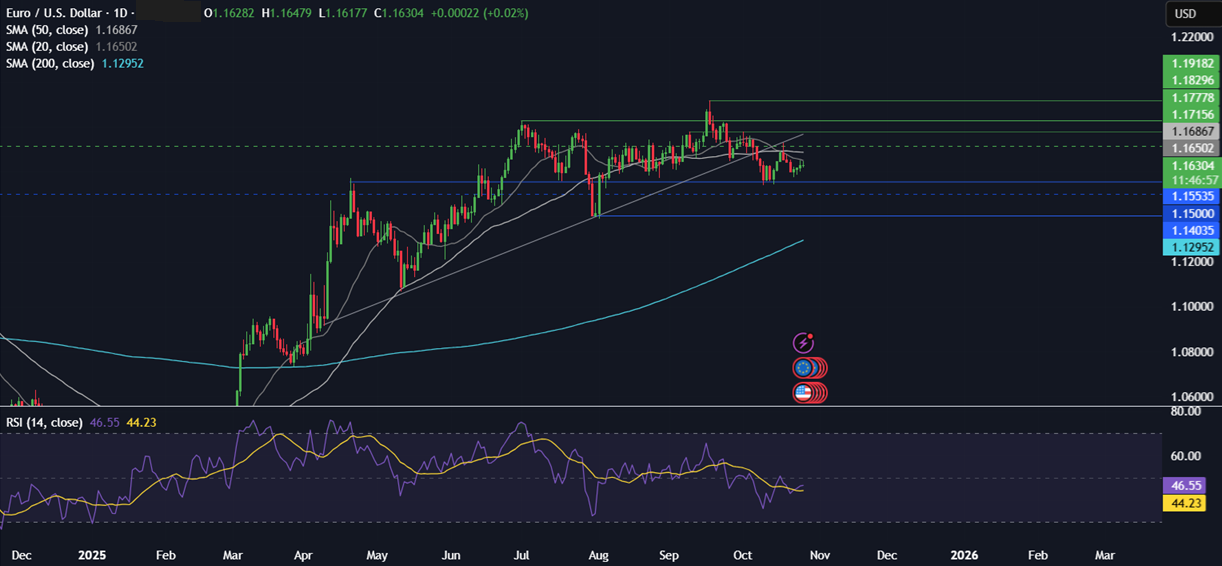
BoJ rate decision (Thursday)
The BoJ is expected to leave its policy rate unchanged at 0.5% on October 30th. Whilst the division among policymakers remains and the BoJ is closer to a hike, there is little need to rush nd there is no urgency at this point. At the September meeting, the BoJ voted to keep rates unchanged by a 7-2 vote. Inflation has ticked higher up to 2.9% while the economy is showing resilience despite headwinds from US tariffs. These should support a future hike from the BoJ. However, given a wariness over premature tightening, a rate increase is likely to be pushed to December. Interestingly, the yen has come under pressure this week despite expectations of a BoJ rate hike before the end of the year amid concerns over rising debt levels, as the new PM Sanae Takaichi, a fiscal dove, pledges enormous spending and is likely to tolerate one more rate hike, but then no further moves until 2027.
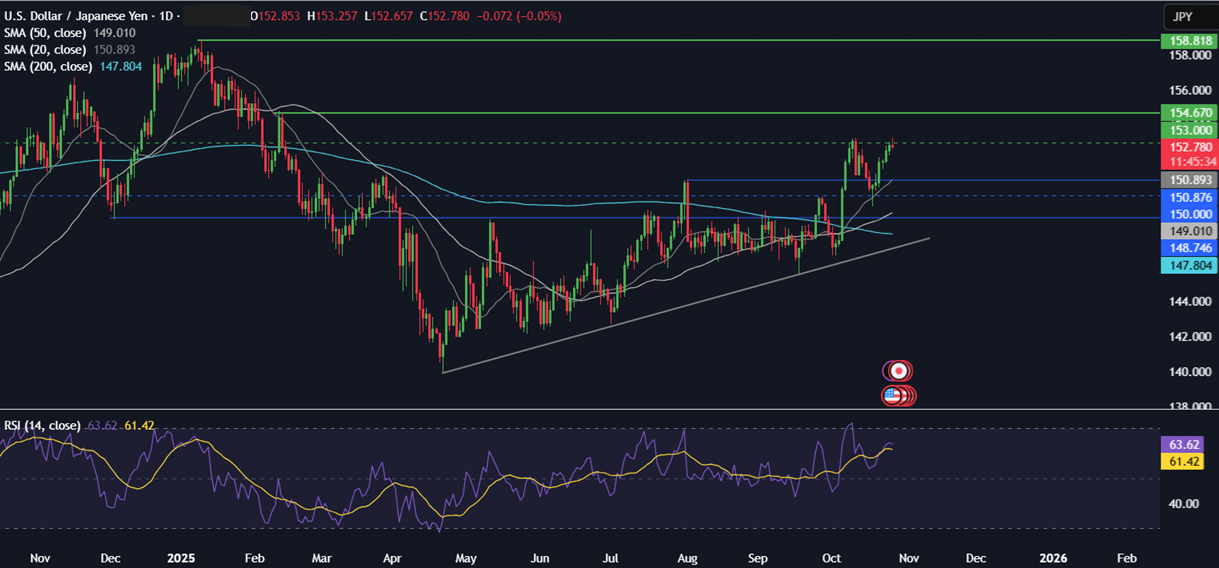
Trading involves risk.
The content provided here is for informational purposes only. It is not intended as personal investment advice and does not constitute a solicitation or invitation to engage in any financial transactions, investments, or related activities. Past performance is not a reliable indicator of future results.
The financial products offered by the Company are complex and come with a high risk of losing money rapidly due to leverage. These products may not be suitable for all investors. Before engaging, you should consider whether you understand how these leveraged products work and whether you can afford the high risk of losing your money.
The Company does not accept clients from the Restricted Jurisdictions as indicated in our website/ T&C. Some services or products may not be available in your jurisdiction.
The applicable legal entity and its respective products and services depend on the client’s country of residence and the entity with which the client has established a contractual relationship during registration.




